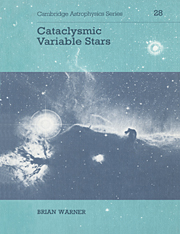4 - Nova-like Variables and Nova Remnants
Published online by Cambridge University Press: 23 December 2009
Summary
A remnant of uneasy light.
W. Wordsworth. Memorials of a Tour in Scotland.A variety of stars was early recognised to have eruptions that bear some resemblance to those of novae. Consequently, a very heterogeneous class of nova-like variables (NLs) was introduced (see, e.g., Campbell & Jacchia 1941; Kukarkin et al. 1958; Petit 1987), which, with hindsight, is seen to include many types of object that are totally unrelated structurally to the true novae. For example, η Car, γ Cas and P Cyg stars do not have the duplicity of CVs. Symbiotic stars, on the other hand, may all be close binaries and some may contain degenerate components as in the CVs (Kenyon 1986).
With the removal of these eruptive objects to their own classes, paradoxically only the non-eruptive residue remained as NLs (many of which, however, may have ‘low states’). It is from their short time scale spectroscopic and photometric behaviour (including the evidence of binary structure) that such stars are recognized as resembling novae between eruptions (they could more appropriately have been termed ‘NR-like’).
Classifications
From the incomplete discovery of novae in earlier centuries (Section 1.1) it is clear that among the NLs there should be many unrecognized NRs. Similarly, the fact that many novae discovered this century can be found as blue objects on archival sky survey plates shows that among the currently known NLs must be a number of pre-novae.
- Type
- Chapter
- Information
- Cataclysmic Variable Stars , pp. 216 - 256Publisher: Cambridge University PressPrint publication year: 1995

